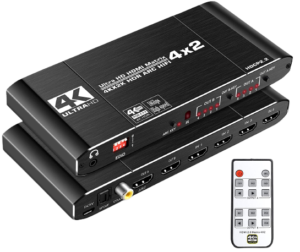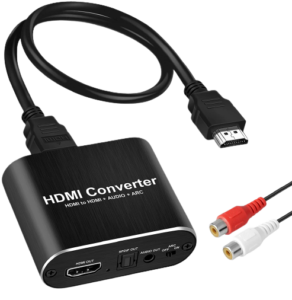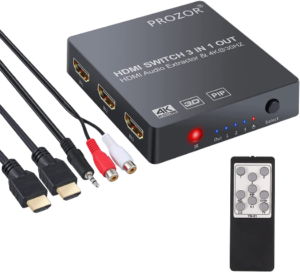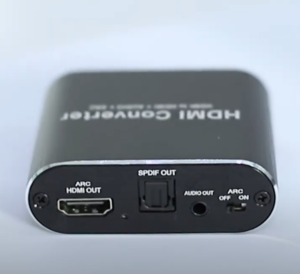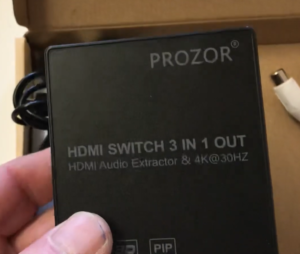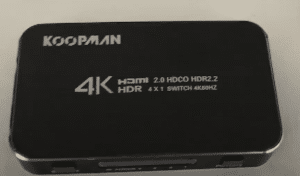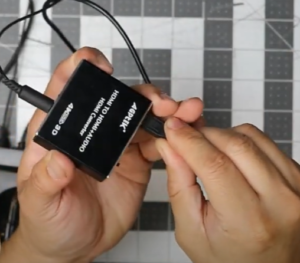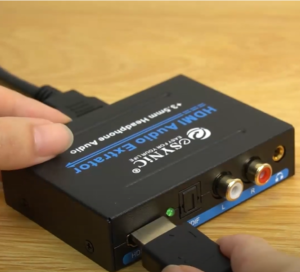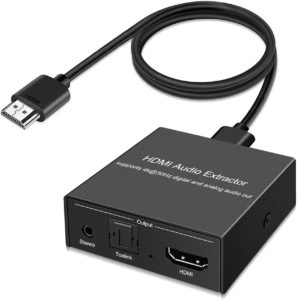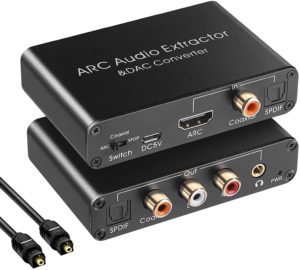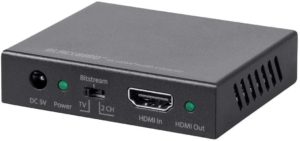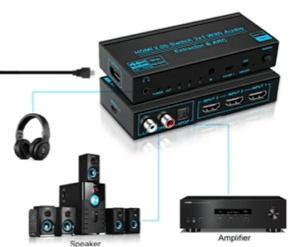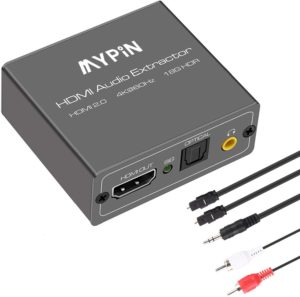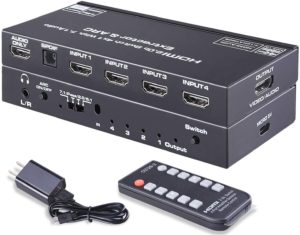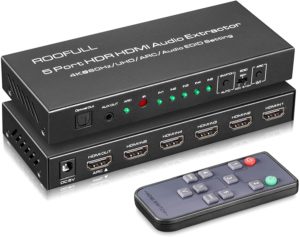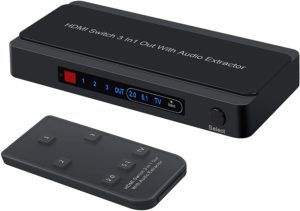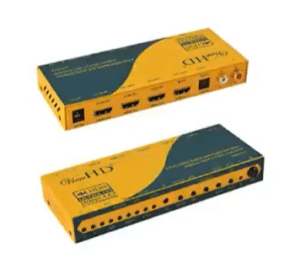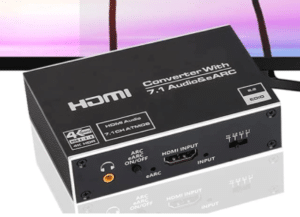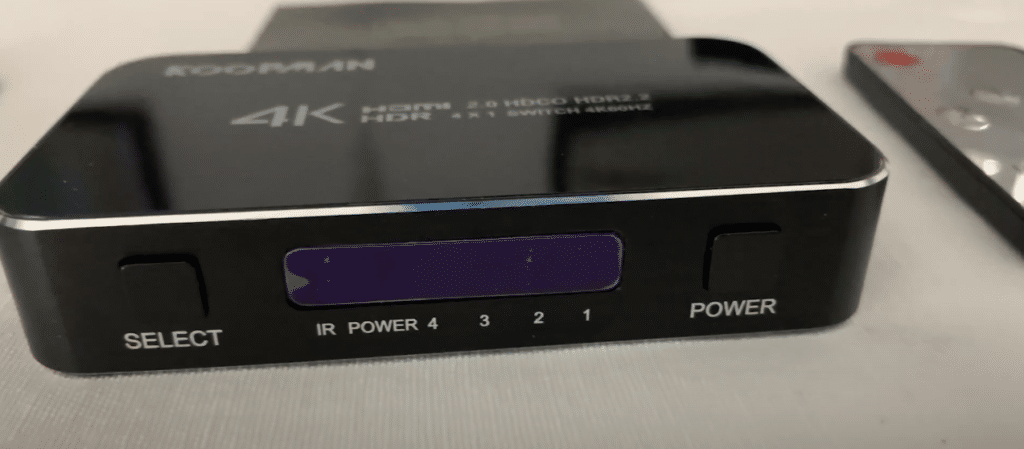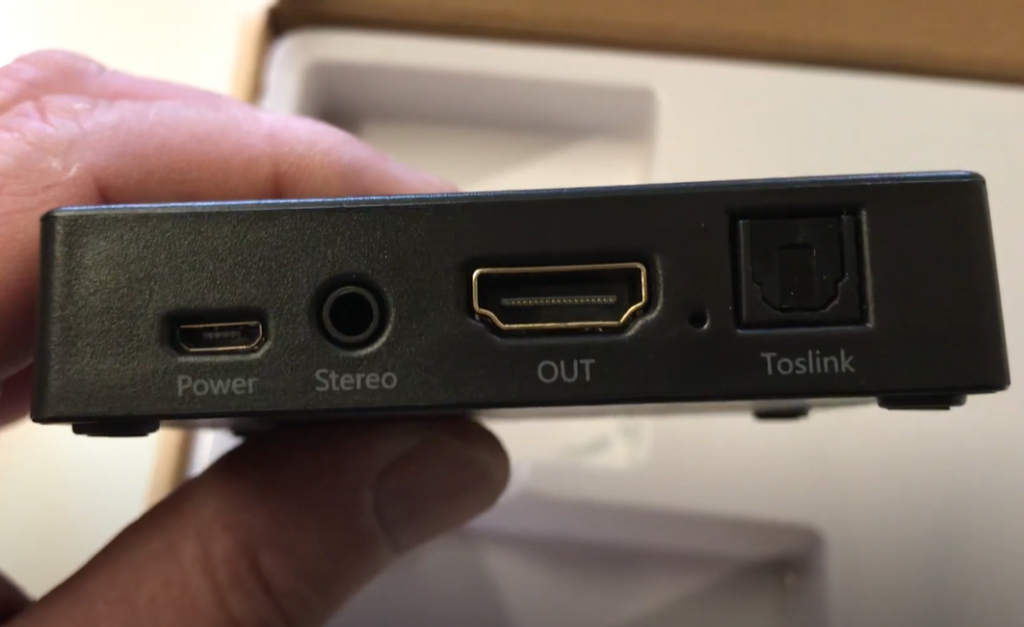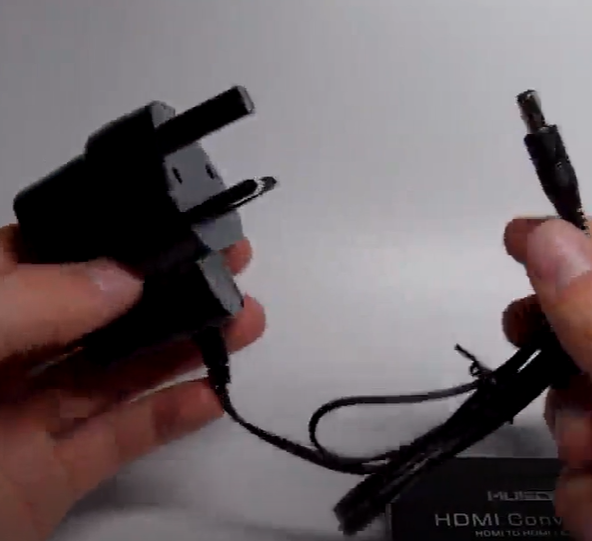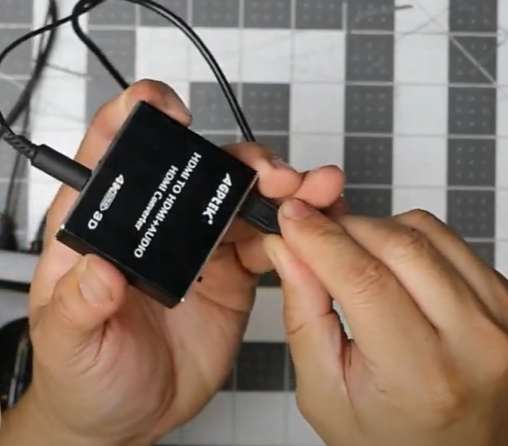-
Willie Greer
As a homeowner, upgrading your home theater system can be a tough task to complete. And while there are many HDMI audio extractors to aid you in this hard quest, not every audio splitter in the market can support your media component. Fortunately, our sound engineers and audiophiles tested some of the best options out there. Let’s check them out, shall we?
Audio Extractor
- Audio EDID settings
- Dolby Digital Compatible
- Audio formats: 4K 60Hz
-
4 HDMI Audio
Signal sources - Audio Support: 5.1 Channel
Audio Extractor
- 3 Audio HDMI Switch
- High Resolution: 4K 60Hz
- HDMI Audio Return Channel
- DTS HD Master Audio
- One HDMI input
- One HDMI output
Audio Extractor
- HDMI Input resolution: 4K 30Hz
- Audio EDID settings: 5.1 channel
- Three HDMI inputs
- Multiple HDMI devices
- One HDMI output
- Dolby Digital & DTS
Reviews of the Top HDMI Audio Extractors
avedio links HDMI Audio Extractor
Suppose you have a component that doesn’t receive a digital HDMI audio signal; having the likes of avedio links HDMI Audio Extractor will make your setup easier. With maximum resolution support of 4K 60Hz, our experts can assure you that it can deliver excellent sound output.
Besides that, this 1080p HDMI Audio Extractor includes audio EDID settings for 2 or 5.1 channel setup and an output port of Sony Philips Digital Interface (SPDIF) audio. Another feature that impressed us is its wide compatibility with different HDMI devices. No matter what component we tried, from Blu-Ray to Apple TV, we were able to split audio seamlessly, minus the hassle.
What We Like
- High compatibility with any HDMI device
- Offers free lifetime support for technical concerns
- Has an Audio Pass for 2 or 5.1 Channel
- More affordable than premium HDMI audio extractors
- Includes multiple HDMI switch audio settings
- Dolby Digital, Dolby TrueHD, & DTS HD Master Audio
What We Don't Like
- Low-voltage HDMI input source needs power adapters
- Bluetooth headset devices are not supported
Proster HDMI Audio Extractor
Converting your video and audio signals doesn’t have to be all that expensive, so our testers decided to give Proster HDMI Audio Extractor a try. Despite a lower price than a premium HDMI extractor, this unit caught our attention with its durable ABS plastic exterior and elegant 24K gold-plated wires that reduce audio signal loss.
Upon inspecting, we also noticed that this HDMI 2.0 switch has three HDMI inputs and one HDMI output meant for Optical Toslink or stereo audio output. If you own an Apple TV, Chromecast, or Roku device without dedicated audio output, this HDMI switch can offer a quick and affordable fix to your dilemma.
What We Like
- Purchase comes with audio and HDMI cables
- More budget-friendly than other audio extractors
- Suitable audio splitters for stereo speakers
- Best for devices without dedicated audio output
- Has three available audio output modes
What We Don't Like
- No provided support for HDCP 2.2
- HDMI signal can’t be converted to DVI
Musou 4K HDMI Audio Extractor
For a straightforward conversion of audio signals, it’s wise to get a basic audio extractor like the ones we tried from Musou. Besides being a highly affordable option, it simply includes one HDMI input and output to solve your typical audio equipment dilemma.
It may surprise you, but its audio output supports DTS 5.1 Channel, RCA analog audio L/R, and 2 Channel PCM stereo output. Thanks to its video pass-through and plug & play features, our testers had an easy time integrating the Musou HDMI extractor with components like a Blu-ray player and Apple TV.
What We Like
- Plug and play feature for an Apple TV
- Costs a lot lower than other audio extractors
- Audio settings for L/R or stereo output
- Has support for compressed audio
- Dolby Digital, Dolby True HD, & DTS-HD
- Supports LPCM uncompressed audio
What We Don't Like
- HDMI cable not included in the purchase
- Safer to use with a power adapter from the same manufacturer
AGPtEK HDMI Audio Extractor Splitter
Some sound systems don’t include an optical output, which is why AGPtEK HDMI Audio Extractor is a sure tool to feed your component a converted HDMI signal. When our audiovisual team tried to use it to extract audio, the audio output allowed up to 4K 30Hz audio and video resolution.
At first glance, you’ll easily notice the top-notch build quality of this audio extractor converter. Its EDID settings include audio-pass for 2CH and 5.1 Channel with support for 2CH PCM LPCM stereo audio. On top of that, it has optical Toslink SPDIF audio support that’s compatible with Dolby Digital and DTS Master Audio.
What We Like
- Has the best HDMI audio extractor exterior build
- Suitable digital audio quality for true 4K picture
- Works for a Blu-ray player or an Apple TV
- Has an optical Toslink SPDIF output
What We Don't Like
- May need an external USB power supply
- Moderately expensive than a typical audio extractor
eSynic HDMI Audio Extractor
It’s not every day that we encounter an HDMI Audio Extractor with a metal casing, so our testers didn’t pass up the chance to evaluate this unit from eSynic.
Other than that, what impressed us the most was its overall shielding. With this feature, it can prevent any HDMI signal interference. Like a typical extractor that can convert HDMI audio, it consists of one HDMI input and an HDMI output that supports SPDIF L/R and analog audio.
We also noticed that the eSynic HDMI extractor has gold-plated connectors, which helps greatly in enhancing the audio and video outputs.
What We Like
- Can easily deliver 4.2 surround sound audio
- Has 5.1 Channel audio mode option
- Compatible with PS3, Apple TV, or PS4
- Built with durable metal exterior and shielding
What We Don't Like
- HDCP 2.2 not supported
- HDMI audio extractor not suited for Fire TVs
Koopman 4K HDR HDMI Switch
If you’re looking into connecting multiple video and audio components simultaneously, Koopman audio converter extractor can help you with its 4 HDMI inputs. It works with one audio output best used for projectors, HDTVs, and other video output displays.
With its IR controller, our testers had a convenient experience navigating its audio mode switch settings. You can switch and extract audio with the remote even if you’re 15 feet away.
And did you know that it’s compatible with different HDMI inputs? It doesn’t matter if you want to convert signals from an Xbox, Cable Box, or Apple TV. These audio extractors will surely cover your HDMI cable conversion needs.
What We Like
- Suits different audio and video output requirements
- Engineered with four available HDMI input ports
- Delivers superb video and audio quality
- Compatible with a cable box and Apple TV
- Includes HDCP 2.2 support feature
What We Don't Like
- No HDMI cable included in the package
- More suitable for lower resolution components
LVY HDMI Audio Extractor
After spending hours searching, our audiovisual team was taken aback after bumping into the affordable LVY HDMI Audio Extractor. Priced a lot lower than other options, we were treated to a big surprise upon knowing that this unit caters to resolution up to 4K 30Hz.
Not only that, it has both SPDIF optical output and stereo audio output support that are helpful for HDMI signal separation and synchronization. Like HDMI audio extractors with a higher price, users can expect three audio modes—the analog stereo output, Toslink digital audio outputs, and 2 & 5.1 Channel outputs.
There is no need for any software because this HDMI audio extractor has plug-and-play features.
What We Like
- Include three different audio output modes
- Extremely affordable HDMI audio extractor
- Has available support for analog stereo output
- Converts uncompressed audio formats
- Has a maximum bandwidth of 340MHz
What We Don't Like
- Requires power adapter (sold separately)
- Not suitable for Bluetooth headsets
SOUCOR HDMI ARC Audio Extractor
Another option you can consider for converting analog and digital audio signals is SOUCOR HDMI ARC Audio Extractor. For a video component with no dedicated audio output, a converter that can accommodate an optical cable via ARC interface is a convenient tool.
Its CEC settings are also adjustable. We tried switching it to HDMI ARC mode during the testing, and we easily got control access to the TV’s volume. On top of that, it allows conversion to several HDMI outputs like coaxial digital audio, RCA L/R, PCM/LPCM, and many more.
What We Like
- Supports 5.1 surround sound audio
- Compatible with many audio format options
- Has multiple HDMI output options
- Offers a variety of HDMI input ports
- Dolby Digital and DTS audio format
What We Don't Like
- Only works for HDMI ARC ports
- Must be set to PCM/LPCM form
Monoprice Blackbird 4K HDMI Audio Extractor
Not all HDMI audio extractors are affordable. And while the Monoprice audio converter extractor is priced higher than usual, it can cover your multi-channel optical audio needs. It also allows signal conversion through the 5.1 Dolby Digital channel and DTS audio output.
Besides its HDMI output and input options, this unit has full compliance with HDCP 2.2 and HDMI 2.0 device standards. Upon closer look, we also noticed it has available L/R audio output suited for active speakers.
If you’re using AV receivers, it has an optical audio output ready for use. The same goes for DVD/Blu-ray players with their HDMI input and output ports.
What We Like
- Complete ports for HDMI outputs and inputs
- Great pair with Apple TV Gen 4 component
- Shows no audio and video degradation
- Compatible with Dolby Digital surround sound
What We Don't Like
- Higher cost than most HDMI audio extractors
- Not amenable for components with Dolby Vision
FERRISA HDMI Audio Extractor
If you need to switch audio and separate its signals at the same time, the FERRISA HDMI audio extractor can definitely cover it all for you. With its three audio mode selections and three switching methods, this equipment will suit your multiple audio setup needs.
It also offers a wide variety of compatibility with sound formats like Dolby TrueHD, DTS-HD, DTS, AC3, and many more. On top of that, it has an ARC function as well. However, we advise you to ensure that all input devices are turned on to avoid delays in the connection process.
What We Like
- Great HDMI audio extractor with easy switch
- Suitable for multiple-channel audio visual setup
- Offers relatively high resolution up to 4K 60Hz
- Includes both HDMI cables and remote
- Auto, Button, and IR Remote Controls
What We Don't Like
- Moderately higher in pricing than other options
- Volume can’t be controlled with headphones
MYPIN HDMI Video Audio Extractor
Switching back to a much more affordable option, our testers encountered MYPIN HDMI Video Audio Extractor. Having both features of an extractor and splitter, we already expected the wide compatibility range of this device.
Its lower price tag is also accompanied by three sound settings and a plug-and-play feature that makes this unit more convenient for users. But out of all its functions, its low consumption options impressed our team the most.
Unlike others, it doesn’t need a power adapter to operate. However, we would recommend having a USB power plug on hand for devices with low voltage ports like PS4.
What We Like
- Has a high compatibility range
- Can be used as an extractor and a splitter
- Designed with plug and play features
- Very affordable and easy to use
- Features low power consumption
- Delivers a great audiovisual experience
What We Don't Like
- May require power adapter for some devices
- Doesn’t include the ARC function
Tendak HDMI 7.1 Audio Extractor
Moving on to a much higher price range, Tendak HDMI 7.1 Audio Extractor proved its place in this list with its high-quality audio conversion owed to its 4-port switch. This unit eliminates the need for AV receivers and amplifiers.
Most devices in the HDMI interface are supported by this audio extractor. In fact, our audio team didn’t have much problem connecting it to Xbox 360 and PS4 during the testing. As a device truly meant for a modern home theater system, this equipment is geared with the latest HDMI 2.0 standard and 18 Gbps bandwidth.
What We Like
- Seamless and no delay connection with other sources
- Supports most components with HDMI interface
- Has four ports for multiple channel connection
- Well-engineered with an EDID configuration
What We Don't Like
- Not for decoding audio formats
- Limited remote control sound adjustments
ROOFULL HDMI 2.0a Audio Extractor
Rather than go low, our team decided to shift our attention to the best HDMI audio converters with higher prices like the ones from ROOFULL. Different from the typical extractor, this unit allows up to 5 HDMI source components to be hooked up in its system.
For its outputs, we found no hassle on compatibility because the ROOFULL HDMI 2.0a extractor supports formats like Dolby Digital surround sound and DTS. There’s no sweat in switching source devices as well because this unit comes along with a remote controller that gives users more convenience.
What We Like
- Has premium quality and build
- Allows connection up to 5 HDMI devices
- Includes remote control for easy switching
- Built with an Audio Return Channel function
What We Don't Like
- Costs more than typical extractors in the market
- Its AUX ports have no ARC support
LiNKFOR HDMI Audio Extractor
With three input ports, L/R outputs, and HDMI output, one look at LiNKFOR HDMI Audio Extractor, and we already know it’ll make it on this top list. Not only because many components can be connected on the said device, but also because it allows connection with 5.1 Dolby Digital surround sound.
It may not be the best HDMI audio converter on this list, but it has a unique PIP feature that allows switching main displays. Its remote also came in handy for us during the entire testing period. The users can choose between manual and remote switching depending on which mode is selected.
What We Like
- Supports devices with Dolby surround sound feature
- Has enough inputs for a multi-channel connection
- Includes a unique display switching function
- Suitable audio extractor for Chromecast and Roku
What We Don't Like
- Not supported by HDCP 2.2 standards
- Incompatible with Netflix and Youtube
ViewHD Switch with Audio Extractor
If we’re talking about the exterior build, ViewHD Switch with Audio Extractor is definitely a few steps ahead of others. However, besides its distinctive design, this unit supports different technologies like Dolby Vision, ARC, and HDR.
If that’s not impressive enough for you, it may surprise you that it has an audio-only output specifically dedicated to ensuring the best compatibility to every single sound format.
Its auto-switching features can be turned on and off according to the user’s needs as well. Besides that, its switch gives you an option to select which port to use, inactive or not.
What We Like
- Built with a visually pleasing design
- Supports all the latest audio formats
- Secured with the best compatibility features
- Has a switch for a more convenient usage
What We Don't Like
- Has premium price range
- OUT B port isn’t CEC-supported
Groza Switch with Audio Extractor
Continuing on our best audio converter search, our audiovisual experts came across Groza Switch with Audio Extractor. Like any other premium device at the same price, its high-performing 4-port design immediately caught our attention. We’re confident that this unit can deliver well with a max resolution capacity of 4K 60 Hz.
Unique to this product is its four audio mode switch settings. Besides the typical 2CH PCM, 5.1 CH surround sound, and Dolby, it supports 7.1 Channels. No video or audio distortion was observed by our team as well, thanks to its ARC function.
What We Like
- Allows 4-port HDMI connections
- Delivers a max resolution of 4K 60Hz
- Has four audio modes and support
- Includes an ARC function for less distortion
What We Don't Like
- Only for pass-through sound formats
- No auto switch for Apple TVs
NEWCARE HDMI Audio Extractor
The best HDMI audio extractors often come at similar prices, but if you have a few more bucks to spare, we recommend buying a NEWCARE HDMI switch. Users can expect easy operations when using this product, which is a premium audio extractor converter. It comes with an IR controller and an LED indicator for device status.
These HDMI 2.0 extractors can split audio and video signals with Optical Toslink SPDIF or 3.5mm Jack Audio Output. It also supports modern audio formats like Dolby Digital and Dolby True HD.
It suits the needs of modern home theater systems with its 4K 60Hz resolution and HDMI audio return channel compatibility.
What We Like
- Delivers max resolution of 4K 60Hz
- Premium quality 1080p HDMI Audio Extractor
- Compatible with Audio Return Channel HDMI cables
- Superb audio quality with 4K 60Hz resolution
- Allows support for different digital audio formats
What We Don't Like
- More expensive than some HDMI Audio Extractors
- Must be installed according to the user manual
HDMI Audio Extractors Buyer’s Guide
Extractor Type
You may not know it, but when you shop for an HDMI extractor for your audio and video components, you’ll encounter two types of products. There’s an extractor that only delivers audio output, and there are also ones that come with a surround sound feature.
These audio outputs have their own perks necessary to your home theater integration, so let our experts tackle them below carefully.
With Audio Outputs
HDMI audio extractors that are labeled with audio outputs are most commonly known as RCA, optical, coaxial, and AUX. These options are popular for having a digital audio output or surround sound feature.
With Audio and Video HDMI Outputs
If you have a video and audio component that doesn’t deliver digital output, this is the best HDMI audio extractor for you. Not every audio output is the same, but most units falling under this category have 4K 60Hz pass-through. Occasionally, you’d encounter ones with 4K 30Hz resolution or lower.
On top of that, these audio converter extractor options also support HDCP 2.2, HDR, and HDMI 2.0 standards.
Number of Ports and Compatibility
The best HDMI audio converter for you will always depend on your component’s requirements. So before you hit the store to find yourself a reliable audio extractor converter, our experts advise you to assess how many devices you intend to integrate into your equipment.
When shopping, some of the most common extractors you’ll find are ones with two inputs and one output. These options are usually smaller and can only accommodate one HDMI source and L/R component.
And then, there are also ones with four HDMI input ports, which are much suited for multi-channel connections. It can be very rare, but the market also has 5-port devices. However, these products are typically priced higher than the rest.
Besides that, the best HDMI audio converter must have wide compatibility with different components. Suppose you read through the product labels and instructions well enough. In that case, you’ll notice that manufacturers include a list of compatible devices like Apple TV, DVD players, game consoles, and many more.
If it’s not indicated, our team recommends reading through the HDMI input and output specifications. For users who intend to connect AV receivers, the audio extractor you should use should have an optical audio output port.
On the other hand, Blu-ray and DVD players will require HDMI output ports. You wouldn’t need to worry about that because most audio extractor converter products in the market automatically have it, considering HDMI has been the standard connection for modern components.
You should also check if your HDMI switch has L/R HDMI output because it’s the required port requirement for active speakers.
Don’t forget to check if the audio extractor supports uncompressed and compressed sound formats. These specifications will tell you if the converter will work on certain devices that run with Dolby Digital surround sound, DTS, or Dolby Vision.
Resolution
If what you seek is an audio extractor for your video component, it’s best to check out the HDMI output resolution of the product. Ideally, you’d want your chosen product to match the specification of your component.
If you ask our experts, it should be at least 1080p or 4K resolution. Why? Because it’s the standard specification for the typical displays available in the market. However, we don’t discourage buying ones with lower resolution. Just make sure it matches your needs.
Let’s say your TV needs 4K/60Hz resolution. We wouldn’t recommend purchasing an audio extractor with an HDMI output of 4K/30Hz. Doing this would only affect the performance of the extraction. Most of these HDMI audio extractor units also indicate the maximum resolution they can handle, so keep your eye out on those.
Audio Settings
Next, get an in-depth look at the EDID settings of your audio extractor. This section of the unit usually dictates how seamless the connection between the source device and the output will be. As soon as you check it, you can easily tell the crucial specifications of your audio converter extractor, such as its frame rate.
Ease of Use
As you may have noticed, most HDMI audio extractor devices our testers listed include plug and play features. This modern function gives the users the ease of not needing to install any software to use their purchased device.
These types of audio extractor converters are also known for being convenient and portable because they can be set up rather quickly.
On top of that, you should check on the labels on the exterior of your audio extractor. No matter how many features it delivers, if these ports don’t have appropriate labels on the surface, the users may be confused when using the device. This case is especially true for newbies who are not knowledgeable about audio setups.
Make an extra effort to check if each one has correct labels and if they’re exactly the ones you’ll need for your audiovisual integration.
Additional Features
Not every audio extractor has it, but having a gold-plated connector is a feature that reduces audio signal loss. In addition to that, it’s good to have converters that support ARC-enabled devices.
There are also ones with excellent EDID management and DIP switches. With these features, our experts can assure that you can expect the best HDMI audio performance from your connected components.
Last but not least, HDMI audio extractors often come with remote controllers nowadays. In fact, this feature is a necessity for people who are setting up multi-channel systems. With a controller, the user can conveniently press a command or switch components freely, even at a further distance.
Price and Warranty
The price range of HDMI audio extractor products doesn’t shy away from one another. They’re pretty much in the same range of $20 to $28. However, you’d find ones sold under $15. While you may think that it’s a great find, we advise you to check their HDMI input and output specs as most only have the basic ports and may not have what your component requires.
Besides that, you’ll notice that HDMI audio extractor converters priced $30 to $60 above have a more durable built and exterior material. These types of devices also often come with a complete set of HDMI input and output ports one may need for signal conversion.
And then, you’ll also encounter extractors sold at $100 above. These products are often multi-functional with many ports and support the latest sound formats out there. While it’s enticing to buy, we would only recommend these for massive audio and video configurations.
Next to the price consideration is the product warranties. With this included in your purchase, you can be sure that you’d have the choice to return the item upon noticing faulty features within a certain amount of time [1].
Most HDMI audio extractor manufacturers offer warranty to the customers to ensure the authenticity of their products. If they don’t, that’s another unchecked box on your option lists. Our audio equipment shoppers recommend buying the best HDMI sound converters on official stores or authorized sellers only.
There are instances that you wouldn’t be able to claim your warranty perks if you bought your devices elsewhere, and it can be a hassle once you find out that your purchase is faulty.
Uses of HDMI Audio Extractors
First and foremost, the main use of an HDMI audio extractor is to separate the audio and video signals coming from an HDMI device source. The process gives a chance for signals to travel through a 2CH analog stereo or digital audio source with an optical jack supported by Dolby Digital surround sound.
Thanks to that process, the audio signals can play in a different device with less interference. If you’re not too familiar with the terms, the HDMI audio extractor simply picks the HDMI audio out to send it to your intended device. This equipment is best used when your component doesn’t have a dedicated audio output.
However, if you’re using a surround sound system, our team doesn’t advise using an HDMI audio extractor. Why? Because these sound formats cannot travel through an HDMI output port. But in a scenario where your Dolby digital surround system has an optical input, you should consider getting an HDMI audio extractor with 5.1 and 7.1 channel modes.
Benefits of HDMI Audio Extractors
If you’re planning to upgrade your home theater system, getting an HDMI audio extractor to hook your sound devices is a great way to start. Having this device at your disposal can be very handy, especially if you have old components that must be integrated with a much recently bought display equipment.
It’s no secret that the HDMI-only display sources like Roku, Apple TV, and other streamers offer ample music options you can listen to. So if your TV doesn’t have the sound power you’re looking for, an HDMI audio extractor can slip the signals to your preferred stereo to elevate your listening experience.
Some may argue that it can affect the sound quality of the media content, but our resident audiophiles assure you that the best HDMI audio converter wouldn’t do that.
Considering how it delivers HDMI signals, the audio performance will remain the same unless it gets affected by other factors like cable length or its maximum sample rate.
HDMI Audio Extractor vs. Audio Splitter
The only difference between an HDMI audio extractor and an audio splitter is their setup. Unlike extractors, splitters get signals from one source and distribute them to two identical components at the same time.
In other words, HDMI extractors handle multiple input sources and deliver signals to one output, whereas the other one splits a channel and transmits its signals to different outputs. An audio splitter sends to many devices, while an extractor only delivers to one.
If you look at its design, you’ll immediately see the difference as well. When our testers looked closer, we took notice of its intuitive build. Splitters also only have one input port and two outputs.
FAQ
Are HDMI audio extractors any good?
Yes, HDMI audio extractors are good. If your component doesn’t have HDMI output, this equipment plays the role of converting the signals to create a seamless connection between devices. It’s helpful if you’re thinking of hooking up your home theater system with some audio devices with analog-only connections.
Do HDMI audio extractors cause lag?
No, HDMI audio extractors don’t cause lag. However, this case is only true if your audio extractor is well-built. The HDMI input pass-through inflicts barely noticeable lag to the signal conversion. If it does, there can be other factors involved, like the signal path caused by short cable length.
Does an HDMI audio extractor work with Chromecast?
Yes, an HDMI audio extractor works with Chromecast on some devices. Your sound extractor device must have a digital optical output port to successfully separate signals and send them to the audio component. You’ll also find these compatibility specifications on your audio extractors’ label or user manual.
Our Top Pick For an HDMI Audio Extractor:
avedio links HDMI Audio Extractor
The best HDMI audio extractors don’t have to be expensive, but they have to be easy enough to connect with different components. Because of this, our audio experts picked avedio links HDMI Audio Extractor as our top pick in this product roundup.
With its EDID settings and ARC support feature, we’re reassured that this unit has enough connection capabilities for both modern and analog devices.

